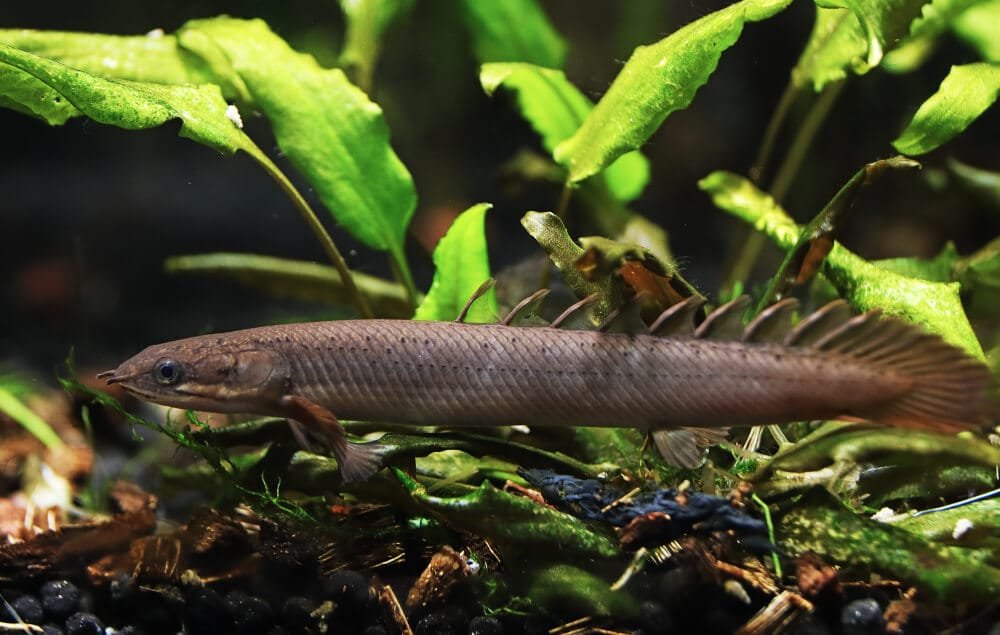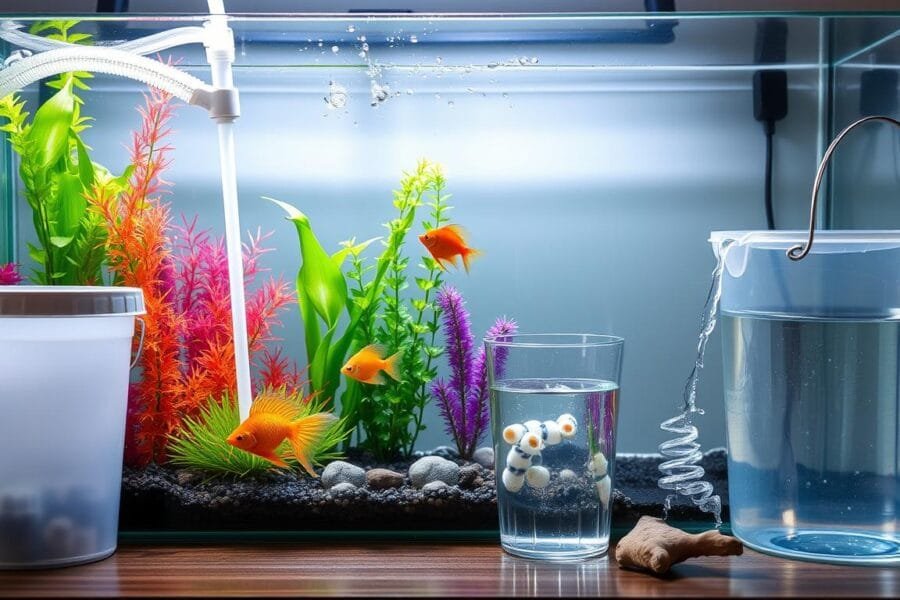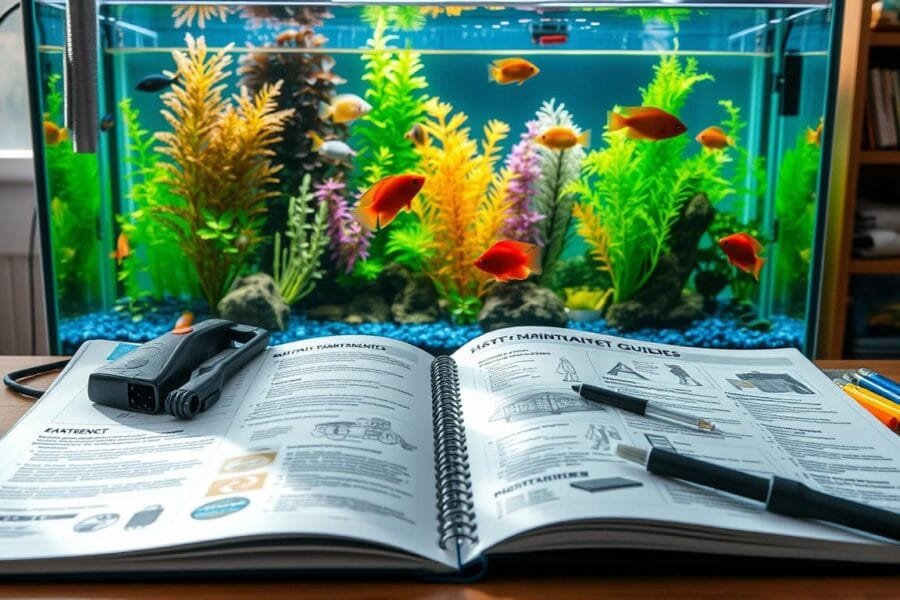Is algae turning your aquarium into a murky mess? Don’t worry! This guide will help you restore your tank’s beauty. Learn how to remove algae and keep your aquarium crystal-clear.
Algae plays a vital role in aquariums. It purifies water and feeds some fish. But too much algae can block your view and harm plants. Let’s find the right balance for your tank.
This guide covers many algae control methods. We’ll discuss manual removal tools and algae-eating animals. You’ll learn to balance lighting, nutrients, and use safe chemical treatments.
Most experienced aquarists use algae scrapers for tough deposits. Regular cleaning prevents stubborn buildup. Consistency is key to maintaining a beautiful aquarium.
You’ll gain insights from real-world stats and expert tips. Learn about ideal lighting to control algae growth. Master using specialized products for calcium residues.
This guide suits both new and seasoned aquarists. You’ll discover secrets to effective algae control. Transform your tank into a stunning underwater showcase.
Understanding Algae in Aquariums
Algae is crucial for a balanced aquarium ecosystem. It helps maintain water quality and balance. However, too much algae can harm other aquatic plants and look unattractive.
The Role of Algae in the Aquarium Ecosystem
Algae purifies water by removing toxic waste chemicals in aquariums. It absorbs excess nutrients and produces oxygen through photosynthesis. Many fish and invertebrates, like snails and shrimp, eat algae as a natural food source.
Types of Algae Commonly Found in Aquariums
Different types of algae can grow in fish tanks. Each type has unique features and growth patterns. Here are some common types of aquarium algae:
| Algae Type | Characteristics | Growth Conditions |
|---|---|---|
| Green Algae | Appears as green spots or patches on glass and decor | Thrives in well-lit environments with low phosphate and CO2 levels |
| Brown Algae | Forms brown, slimy patches on surfaces | Common in new tanks or those with low lighting and high ammonia |
| Blue-Green Algae | Appears as slimy, blue-green sheets or patches | Grows in areas with slow water flow or debris accumulation |
| Hair Algae | Grows in long, stringy strands or tufts | Indicates low or fluctuating CO2 levels and nutrient deficiencies |
Knowing algae types and their growth conditions helps control blooms in fish tanks. Proper water parameters, lighting, and circulation are key. These factors promote a healthy, thriving aquarium ecosystem and minimize excessive algae growth.
Tools for Manually Removing Algae
The right aquarium cleaning equipment is crucial for a healthy tank. Manual algae removal tools are essential for quick results. They work faster than chemical or biological solutions.
Algae Scrubbers and Sponges
Algae scrubbers and non-toxic melamine foam sponges are gentle yet effective. They remove algae without scratching glass or acrylic. Rinse your scrubber after use to prevent algae spore spread.
Mag-Float Glass Cleaners and Scraper Blades
Mag-Float glass cleaners with scraper blades tackle tough algae like green spot algae. These tools use magnets to clean inside the tank without wetting your hands. Choose the right size for your aquarium’s thickness for best results.

Toothbrushes for Hard-to-Reach Areas
Toothbrushes are great for cleaning hard-to-reach spots and plant leaves. Their soft bristles can remove hair algae by twisting it around them. Use a dedicated toothbrush to avoid introducing contaminants to your tank.
Aquarium Siphons for Substrate Cleaning
Aquarium siphons, or gravel vacuums, remove algae-coated substrate and debris. They’re effective against blue-green algae and brown diatoms on the substrate. Regular siphoning prevents organic matter buildup, which can cause excessive algae growth.
| Tool | Effectiveness | Ease of Use |
|---|---|---|
| Algae Scrubber | High | Easy |
| Mag-Float Glass Cleaner | High | Moderate |
| Toothbrush | Moderate | Easy |
| Aquarium Siphon | High | Moderate |
Use these tools regularly to control algae growth in your aquarium. Consistent maintenance is key for a clean, healthy environment. Your aquatic pets will thrive in a well-maintained tank.
Algae-Eating Animals as Aquarium Cleaners
Algae eaters help control algae growth naturally in aquariums. These fish and invertebrates add diversity to your tank. They also play a crucial role in maintaining a healthy ecosystem.
Nerite Snails and Amano Shrimp for Nano Tanks
Nerite snails excel at scraping tough green spot algae off glass and decorations. Their eggs won’t hatch in freshwater, preventing overpopulation. Amano shrimp grow up to 2 inches and eat black beard and hair algae.
For best results, keep at least four amano shrimp in your nano tank. These small cleaners are perfect for maintaining smaller aquariums.
Otocinclus Catfish and Bristlenose Plecos for Larger Tanks
Otocinclus catfish, about 2 inches long, clean plant leaves and surfaces in planted tanks. Keep them in groups of three to six. Bristlenose plecos efficiently clean glass and decorations.
Bristlenose plecos grow to 4-5 inches, suitable for 25-gallon tanks and larger. These algae eaters are popular choices for bigger aquariums.
| Algae Eater | Size | Specialty |
|---|---|---|
| Nerite Snails | 1 inch (2.5 cm) | Green spot algae on glass and decorations |
| Amano Shrimp | 2 inches (5 cm) | Black beard algae and hair algae |
| Otocinclus Catfish | 2 inches (5 cm) | Plant leaves and various surfaces |
| Bristlenose Plecos | 4-5 inches (less than 13 cm) | Glass and decorations |
Siamese Algae Eaters: Effective but Easily Misidentified
Siamese algae eaters control various algae types, including stubborn black beard algae. They’re often confused with Chinese algae eaters, which become territorial as they mature.
True Siamese algae eaters (Crossocheilus oblongus) grow up to 6 inches. Look for a black stripe from nose to tail. Reduce their food to encourage more algae consumption.
By incorporating a diverse mix of algae eaters into your aquarium clean-up crew, you can effectively control algae growth and maintain a healthy, thriving ecosystem. Research each species’ needs and compatibility with your tank inhabitants.
Removing Excess Organics to Control Algae Growth
Controlling algae growth requires removing excess organics from your aquarium. Organic waste fuels algae blooms if left unchecked. By following simple practices, you can reduce organic waste and keep algae under control.
Trimming plants regularly is key for algae prevention. Remove dead or algae-covered leaves during water changes. This improves plant appearance and maintains better water quality.
Siphoning the substrate is essential for reducing excess organics. It removes rotting debris and uneaten food particles. This helps maintain a cleaner tank environment.
Overfeeding can lead to algae growth. Leftover food decomposes and releases nutrients that algae thrive on. Reduce fish food and ensure it’s consumed within minutes.
Improving water flow is crucial for algae prevention. Dead zones with poor circulation can become algae hotspots. Arrange decorations strategically and use stronger filters to eliminate stagnant areas.
| Algae Control Method | Frequency | Benefits |
|---|---|---|
| Trimming plants | During water changes | Removes dead/algae-covered leaves, improves plant appearance |
| Siphoning substrate | Weekly or bi-weekly | Removes rotting debris and uneaten food, reduces organic waste |
| Reducing fish food | Daily | Prevents overfeeding, minimizes leftover food decomposition |
| Improving water flow | Ongoing | Eliminates dead zones, promotes nutrient distribution, prevents waste accumulation |
Consistent use of these strategies will help control algae growth. They remove excess organics and minimize algae nutrient sources. A clean, well-maintained aquarium creates a thriving and stunning underwater ecosystem.
Balancing Lighting and Nutrients in Planted Aquariums
A thriving planted aquarium needs a balance of lighting and nutrients. By managing these factors, you can reduce algae and boost plant health.
Using Outlet Timers to Regulate Lighting Duration
Controlling light duration is key to managing algae in planted tanks. New aquariums should start with 6-8 hours of light per day. Gradually increase this to 8-12 hours as plants grow.
Use a water-resistant IP67 outlet timer to automate lighting. This protects against accidental splashes and ensures consistent light cycles.
Choose a high-quality LED light with a 3-year warranty for your tank. These lights use 10-50% less power than standard options. They can last up to 50,000 hours of operation.
Maintaining Optimal Nitrate Levels through Water Changes and Fertilization
Keeping nitrate levels between 20-50 ppm is crucial for algae control. Achieve this through regular water changes and proper fertilization. Make small changes to nutrient levels every 2-3 weeks.
Gradual Adjustments and Monitoring for Best Results
Make changes to lighting and nutrients slowly. Sudden shifts can upset the tank’s balance and trigger algae growth. Adjust in small steps every 2-3 weeks.
Watch your tank closely after each change. This helps you fine-tune conditions for minimal algae and healthy plant growth.
The goal is to create an environment where algae growth is barely noticeable, allowing your beautiful aquatic plants to take center stage.
By balancing light, controlling nutrients, and making gradual changes, you’ll create a stunning, algae-free planted aquarium.
Chemical Treatments: Hydrogen Peroxide for Persistent Algae
Chemical algae treatments like hydrogen peroxide can tackle stubborn algae growth. A 3% hydrogen peroxide solution effectively eliminates persistent algae, such as black beard algae (BBA). This powerful oxidizer works on plants and decorations in your aquarium.
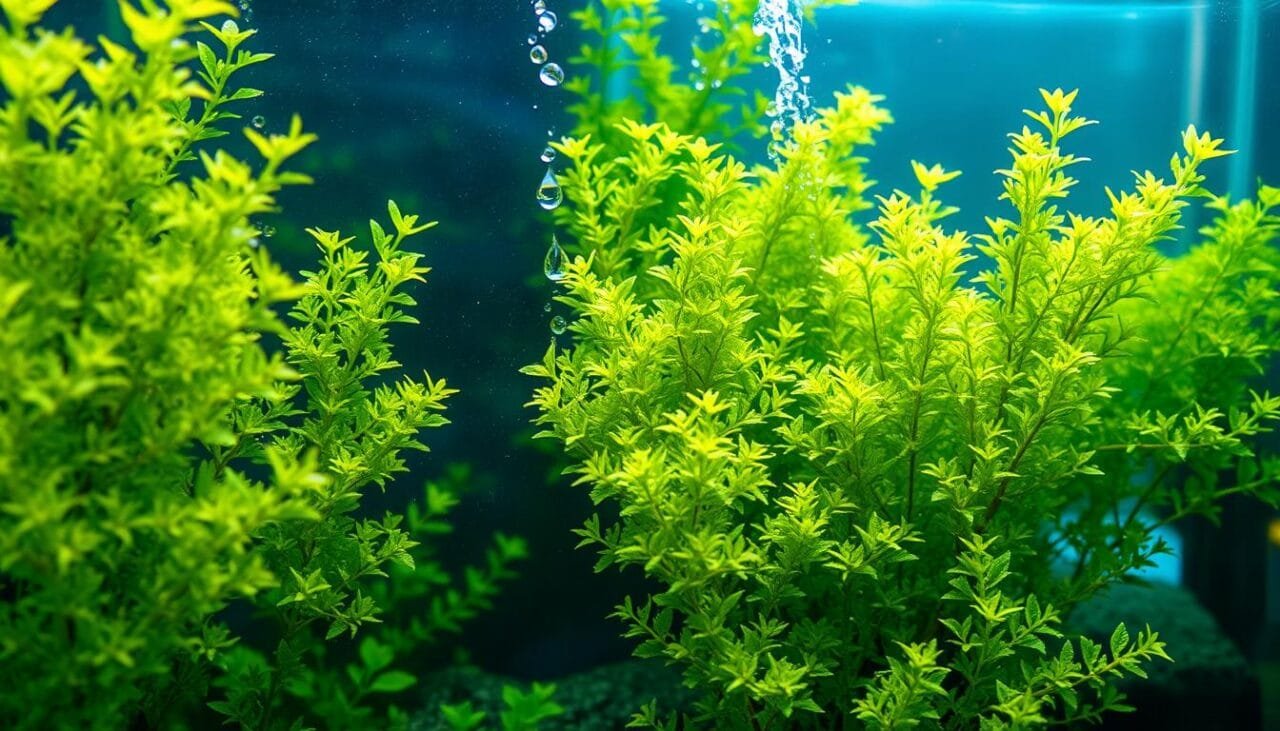
Applying Hydrogen Peroxide to Algae-Covered Plants and Decor
To apply hydrogen peroxide to algae-covered areas, follow these steps:
- Drain the water until the affected areas are exposed.
- Spray a 3% hydrogen peroxide solution directly onto the algae.
- Allow the solution to sit for 5 minutes.
- Refill the tank with fresh water.
For spot treatment, use 2ml of 3% hydrogen peroxide per 10 gallons of water. Start with 0.5ml per 10 gallons for whole-tank treatment. Gradually increase up to 2ml per 10 gallons as needed.
Precautions and Considerations for Sensitive Plants
Take precautions to protect sensitive plants and aquatic life when using chemical algae control. Shrimp, snails, and certain fish may be more susceptible to hydrogen peroxide effects.
To minimize risks:
- Reduce treatment time or test the solution on a small plant section first.
- Monitor dissolved oxygen levels closely, as they may dip after application.
- Perform a 50% water change after treatment to restore safe tank conditions.
After treatment, dying algae may turn red or clear, attracting algae-eating animals. Address underlying issues like lighting and nutrient imbalances to prevent recurring algae growth.
| Tank Size (Gallons) | Hydrogen Peroxide Dosage (ml) |
|---|---|
| 10 | 0.5 – 2 |
| 20 | 1 – 4 |
| 30 | 1.5 – 6 |
| 40 | 2 – 8 |
| 50 | 2.5 – 10 |
Careful consideration of algae treatment precautions ensures effective control of persistent growth. Following proper application methods minimizes risks to your aquatic plants and pets.
Preventing Algae Growth through Aquarium Maintenance
Keeping your fish tank healthy is vital for your aquatic pets. Algae growth is a common issue for tank owners. But with proper aquarium maintenance, you can control algae and maintain a pristine tank.
Algae control needs ongoing care, say experienced aquarium professionals. It’s natural in fish tanks and depends on various factors. Understanding the nitrogen cycle is key to preventing excessive algae growth.
Fish waste produces ammonia, which converts to nitrites and then nitrates. This process affects aquarium health and algae growth. Keeping this cycle balanced is crucial for a healthy tank.
The Importance of Regular Water Changes
Regular water changes are crucial in preventing algae buildup. Experts suggest changing 25% of the water every three to four weeks. This removes excess organics and dilutes nutrients that feed algae.
Many aquarium owners neglect cleaning schedules. This can lead to unhealthy tank conditions and excessive algae growth. Consistent maintenance is key to a balanced ecosystem.
Avoiding Overfeeding and Removing Excess Food
Overfeeding fish contributes significantly to algae growth. Uneaten food decays, increasing ammonia levels and feeding algae. Feed your fish only what they can eat in a couple of minutes daily.
Monitor feeding habits regularly. Remove any excess food promptly to minimize waste accumulation. This simple step can greatly reduce algae problems.
Maintaining Proper Filtration and Water Circulation
Proper filtration and water circulation are essential for preventing algae growth. Use high-grade filters like Poly Filters to remove harmful substances. These filters change color, indicating what they’re removing.
Ensure your aquarium has adequate water circulation. This eliminates dead zones where algae can thrive. Good circulation promotes a healthier tank environment overall.
Consistent aquarium maintenance practices can significantly reduce algae overgrowth. They create a thriving environment for your aquatic pets. Remember, prevention is key in algae control.
The Role of Live Plants in Controlling Algae
Live plants in planted aquariums help control algae. They compete with algae for nutrients and light. Aquatic plants also consume organic waste, keeping nutrient levels low.
Choose aquarium plants based on tank size, water parameters, and lighting. This ensures optimal plant growth and algae reduction. Some great plants for natural algae control include:
- Floating plants: These fast-growing plants utilize light and nutrients before algae can establish, effectively preventing their growth.
- Submerged or tissue culture plants: These adaptable plants are well-suited for maintaining a healthy tank environment.
- Stem plants: Fast-growing stem plants, such as Rotala and Ludwigia species, compete aggressively with algae for resources.
Algae-eating creatures can also help manage algae in your aquarium. The table below suggests some helpful tank inhabitants:
| Algae Eater | Stocking Ratio | Effectiveness |
|---|---|---|
| Otocinclus Catfish (Otos) | 1 per 10 gallons | Consumes GSA, GDA, and diatoms; controls ~2% of algae |
| Amano Shrimp | 1 per gallon | Highly effective algae control |
| Nerite Snails | 1 per gallon | Complete algae management; may have reduced lifespans in soft, acidic water |
| Red Cherry Shrimp (RCS) and similar breeds | Rapid reproduction; cost-effective | Contributes to algae reduction; effectiveness dependent on fish stocking compatibility |
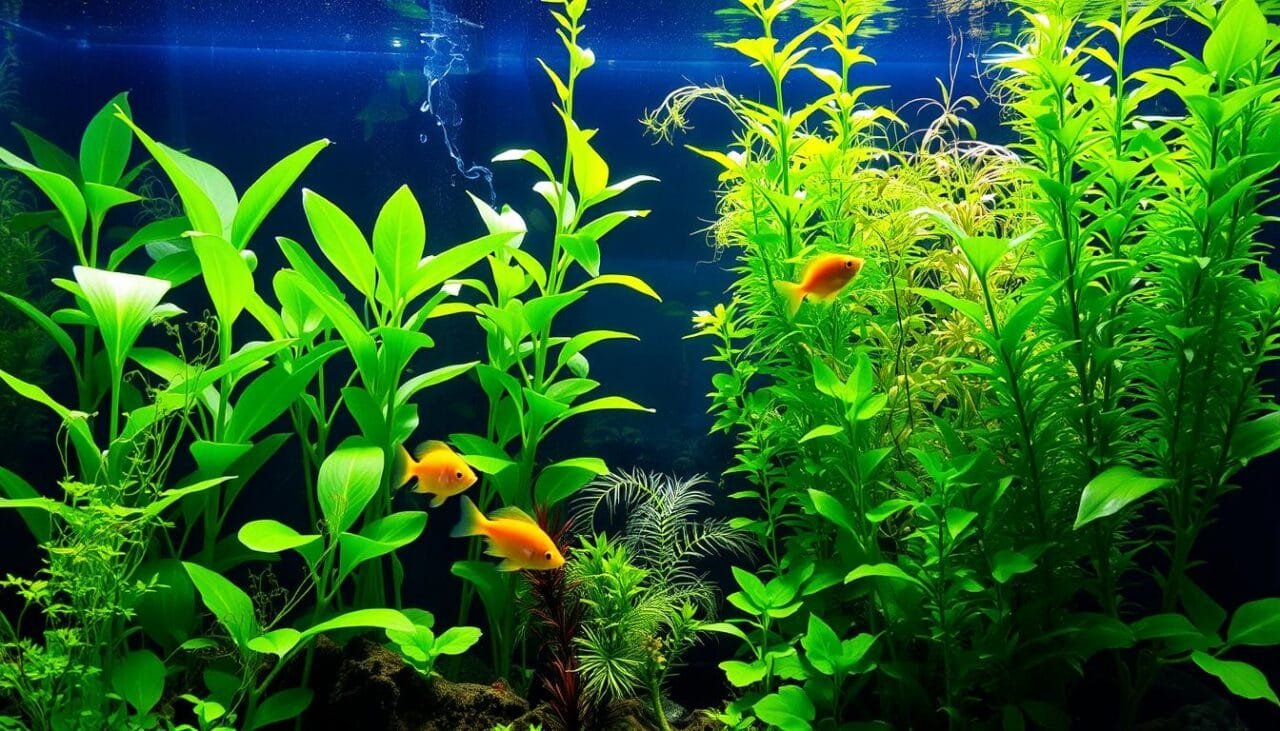
Combine live plants with regular water changes and manual algae removal. This creates a balanced ecosystem that fights algae. Consistent care is key for a healthy, algae-free aquarium.
Cleaning Aquarium Glass and Algae Control: A Continuous Process
Keeping an aquarium crystal-clear requires regular maintenance. Consistent care prevents excessive algae growth and ensures a healthy environment. A well-planned schedule helps maintain a balanced and beautiful tank.
Establishing a Regular Maintenance Routine
Effective algae control needs a consistent cleaning routine. This includes regular water changes, glass cleaning, and filter maintenance. A well-planned schedule helps prevent algae and keeps your tank healthy.
Consider these stats when planning your routine:
- Nitrate levels should be kept at 15-20 ppm or less for saltwater fish and 10 ppm or less for reef tanks. Freshwater fish should have nitrate levels of 40-50 ppm or less.
- Water changes are recommended whenever nitrate levels exceed 40 ppm in established aquariums.
- If more than 20-25% of the aquarium water needs to be changed once per month to maintain low nitrates, it may indicate underlying system or maintenance issues.
Monitoring Algae Growth and Adapting Strategies as Needed
Regular algae growth monitoring is crucial for adjusting control strategies. Watch the amount and type of algae in your tank. Be ready to adapt your approach as needed.
This may involve changing lighting, nutrients, or cleaning methods. These adjustments help maintain a balanced ecosystem in your aquarium.
Consider these tips for effective algae monitoring:
- Perform weekly water testing during the nitrogen cycle in new aquariums, as they are generally more unstable.
- In mature tanks, water testing every 2 to 4 weeks is sufficient if there are no issues.
- Heavily stocked fish tanks require more frequent cleaning of filter sponges as part of weekly maintenance.
- Wiping down the tank can prevent excessive algae growth, especially in saltwater tanks with stronger light systems.
A regular maintenance routine and close algae monitoring are essential. These practices help you make necessary adjustments to keep your aquarium pristine. Remember, continuous care is key to long-term aquarium success.
Common Mistakes to Avoid in Algae Control
Algae control is vital for a healthy aquarium. Many aquarists make errors that lead to algae overgrowth. Learn how to avoid these mistakes and keep your tank clean.
Overfeeding is a common error. It creates excess nutrients and waste, fueling algae growth. Studies show high ammonia levels from overfeeding increase fish stress by 30%. Feed only what fish can eat in minutes.
Excessive lighting often causes algae blooms. Tanks with over 12 hours of light daily have more algae problems. Use timers to control lighting and reduce algae growth by 40%.
Poor maintenance contributes to algae issues. It causes 75% of aquarium failures. Neglecting water changes and ignoring early signs leads to outbreaks. Set up a regular cleaning schedule.
Improper filtration and overcrowding can cause nutrient imbalances. Make sure your filter matches your tank size. Overcrowding increases waste and stress, making algae problems more likely.
Rushed treatments and relying on chemicals can be harmful. Identify the root cause of algae problems first. Adjust your maintenance routine and tank parameters before using algaecides.
Avoid these mistakes to create a thriving underwater environment. Your aquatic inhabitants will flourish in a clean, balanced tank without unsightly algae growth.
Conclusion
Keeping aquarium glass clean and controlling algae growth requires multiple strategies. These include manual removal tools, algae-eating animals, and nutrient management. Balanced lighting and consistent maintenance are also crucial.
Understanding algae growth factors helps create an effective control plan. These factors include excess nutrients, light intensity, and CO2 levels. Regular maintenance is key to preventing algae and keeping fish healthy.
Water changes, proper feeding, and removing excess food are essential. Beneficial bacteria can compete with algae for nutrients. Synthetic adsorbent media can reduce excess nitrogenous waste.
In marine aquariums, algae growth is natural during maturation. A diverse cleaning crew can provide natural algae control. As water stabilizes and bacteria develop, excess nutrients decrease.
Following these strategies helps create a balanced ecosystem. This leads to crystal-clear water for your aquatic pets. Adapt these methods as needed for your specific setup.
FAQ
What role does algae play in the aquarium ecosystem?
Algae helps purify water from toxic waste. It serves as food for algae-eating fish and invertebrates. However, too much algae can block views and harm plant growth.
What are some common types of algae found in aquariums?
Common algae types include green spot, hair, blue-green, and brown diatom algae.
What manual tools can I use to remove algae from my aquarium glass?
Algae scrubbers and non-toxic melamine foam sponges work well. Mag-Float glass cleaners with safe scraper blades are also useful. Toothbrushes help clean hard-to-reach areas and plant leaves.
Aquarium siphons can vacuum algae-coated substrate effectively.
Which algae-eating animals are suitable for different tank sizes?
Nerite snails, amano shrimp, and otocinclus catfish suit nano tanks. Bristlenose plecos and Siamese algae eaters work in larger tanks. Be careful when identifying Siamese algae eaters.
How can I control algae growth by removing excess organic materials?
Trim dead or algae-covered leaves during water changes. Siphon rotting debris from the substrate and avoid overfeeding. Improve water flow by arranging decorations and filling gaps with substrate.
Use stronger filters to eliminate “dead zones” where algae can grow.
What steps can I take to balance lighting and nutrients in my planted aquarium to control algae?
Use outlet timers to limit light to 6-8 hours daily. Adjust nutrient levels gradually and maintain nitrate levels between 20-50 ppm. Make small changes every 2-3 weeks and watch how plants and algae respond.
How can I use hydrogen peroxide to treat persistent algae like black beard algae (BBA)?
Drain water until algae-covered plants and decor are exposed. Spray 3% hydrogen peroxide directly on the algae. Wait 5 minutes, then refill the tank. For sensitive plants, reduce treatment time or test a small section first.
What regular maintenance practices help prevent algae growth in aquariums?
Perform frequent water changes to dilute nutrients. Avoid overfeeding and remove uneaten food promptly. Maintain proper filtration and water circulation to eliminate dead zones.
How do live plants contribute to controlling algae in aquariums?
Live plants compete with algae for nutrients and light. They provide hiding spots for fish and enhance the tank’s look. Choose plants that suit your tank’s size, water parameters, and lighting conditions.
What common mistakes should I avoid when trying to control algae in my aquarium?
Avoid overfeeding, excessive lighting, and infrequent maintenance. Balance nutrients, ensure proper filtration, and avoid overcrowding. Don’t neglect water changes or ignore early algae signs.
Avoid rushing into chemical treatments without addressing underlying issues.



